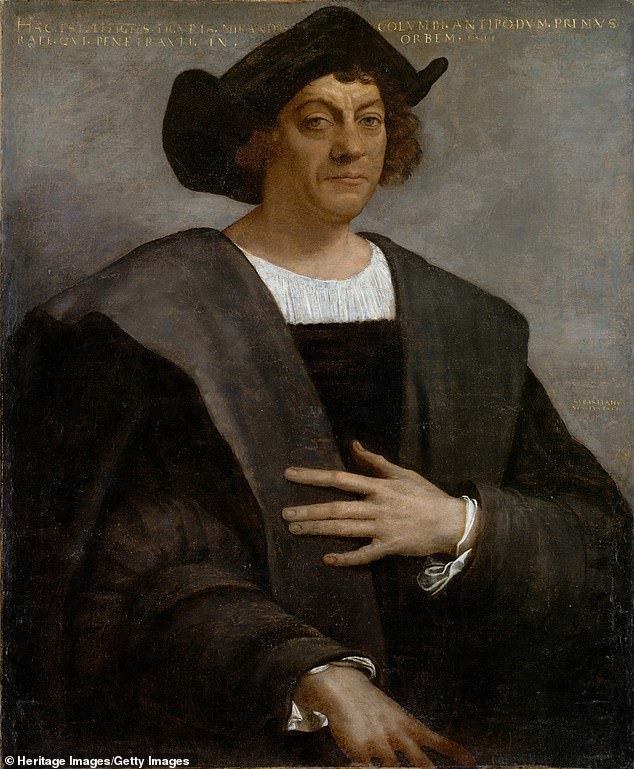Scientists have solved the 500-year-old mystery surrounding Christopher Columbus’ final resting place.
The team spent 20 years performing a DNA analysis on human bones found buried in Spain‘s Seville Cathedral, confirming with ‘absolute certainty’ they belonged to the explorer who died in 1506.
For the past two decades, they have been comparing DNA taken from the samples with that of relatives and descendants.
The findings come just ahead of the U.S. holiday in his name, this Monday, timed to the second Monday in October each year to commemorate the Italian voyager’s Oct. 12, 1492 discovery of the ‘New World’ for Spain.
That itself has been a touch-point of controversy over his treatment of indigenous peoples.
Columbus’ body had been moved several times following his death, with some experts claiming he had been buried in the Dominican Republic, sparking a hunt to track down the navigator’s remains.

Scientists have been working to solve the 500-year-old mystery about where Christopher Columbus was buried
Miguel Lorente, a forensic scientist who led the research, said on Thursday: ‘Today it has been possible to verify it with new technologies, so that the previous partial theory that the remains of Seville belong to Christopher Columbus has been definitively confirmed.’
Many experts have believed that the tomb inside the cathedral has long held Columbus’ body, but it was not until 2003 when Lorente and historian Marcial Castro were granted permission to open it, finding the previously unknown bones were inside.
At the time, DNA technology was not capable of ‘reading’ a small amount of genetic material to provide accurate results.
Researchers used remains of the explorer’s son, Hernando, and brother Diego, who are were also buried at Seville Cathedral.
The relative’s bones were also much larger than the fragments in found in Columbus’ burial.
The advancements in DNA analysis could also reveal whether or not the explorer was Italian, which has also been debated among the scientific community.
Some are sure he was born in Genoa, while others have suggested Poland or Spain.
Then there are speculations that the navigator was Scottish, Catalan or Jewish.
Researchers said their findings on Columbus’ ancestry are due to be announced in a documentary titled ‘Columbus DNA: The true origin’ on Spain’s national broadcaster TVE on Saturday.
Lorente, briefing reporters on the research on Thursday, did not reveal the conclusions, but said they had confirmed previous theories that the remains in Seville belonged to Columbus.
Research on the nationality had been complicated by a number of factors including the large amount of data. But ‘the outcome is almost absolutely reliable,’ Lorente said.
Columbus set sail on August 3, 1492, from the Spanish port of Palos with hopes of finding a route to the fabled riches of Asia.
Along with three ships, the Nina, the Pinta and the Santa Maria, Columbus and roughly 100 men embarked on the journey that took them to the opposite side of the world – and far from their original destination.
On October 12, 1492, the ships made landfall in what is now the Bahamas and later in the month, Columbus pulled spotted Cuba and thought it was mainland China.
And two months later, the ships pulled ashore, which Columbus thought might be Japan.
On the second voyage in 1493, Columbus intentionally sailed back to the New World and landed in Puerto Rico where he enslaved many of the Taino people native to the island – some of which were sent back to Spain.
Many Spanish came over the next four years, resulting in the death of about seven million Taino – 85 percent of the population.

Researchers were granted permission to open a tomb housed in a Spanish cathedral back in 2003, finding bone fragments of an unknown human. Now, the team confirmed the remains are Columbus
The Europeans’ arrival also led to a spread of deadly diseases like smallpox and measles, with many historians claiming Columbus brought also the first syphilis-like diseases to the Americas.
But a study in January found the disease was running rampant thousands of years before.
The first onset of a syphilis epidemic was documented in the late 15th Century in Europe, leading historians to believe it was brought to America when Columbus set foot on the continent.
DNA evidence has now revealed that treponematosis, an age-old syphilis-like disease, existed in Brazil more than 2,000 years before the explorer set sail for the new world.
Kerttu Majander, postdoctoral researcher at the University of Basel, said: ‘The fact that the findings represent an endemic type of treponemal diseases, and not sexually transmitted syphilis, leaves the origin of the sexually transmitted syphilis still unsettled.’
The team examined the bones of four people who died in the coastal region of Santa Catarina in Brazil thousands of years ago.
Pathogens found in teh remains that showed signs of a syphilis-like illness that likely resulted in mouth sores and shin pains.
The study, published in Nature, said the bones were excavated at the Jabuticabeira II archeological site and have been studied since 2016.
Researchers screened 37 out of 99 samples of sequencing data and found there were between seven and 133 positive hits for diseases stemming from the Treponema family.
Verena Schünemann, a co-author in the study, said: ‘Although the origin of syphilis still leaves room for imagination, at least we now know beyond a doubt that treponematoses were no strangers to the American inhabitants who lived and died centuries before the continent was explored by Europeans.











